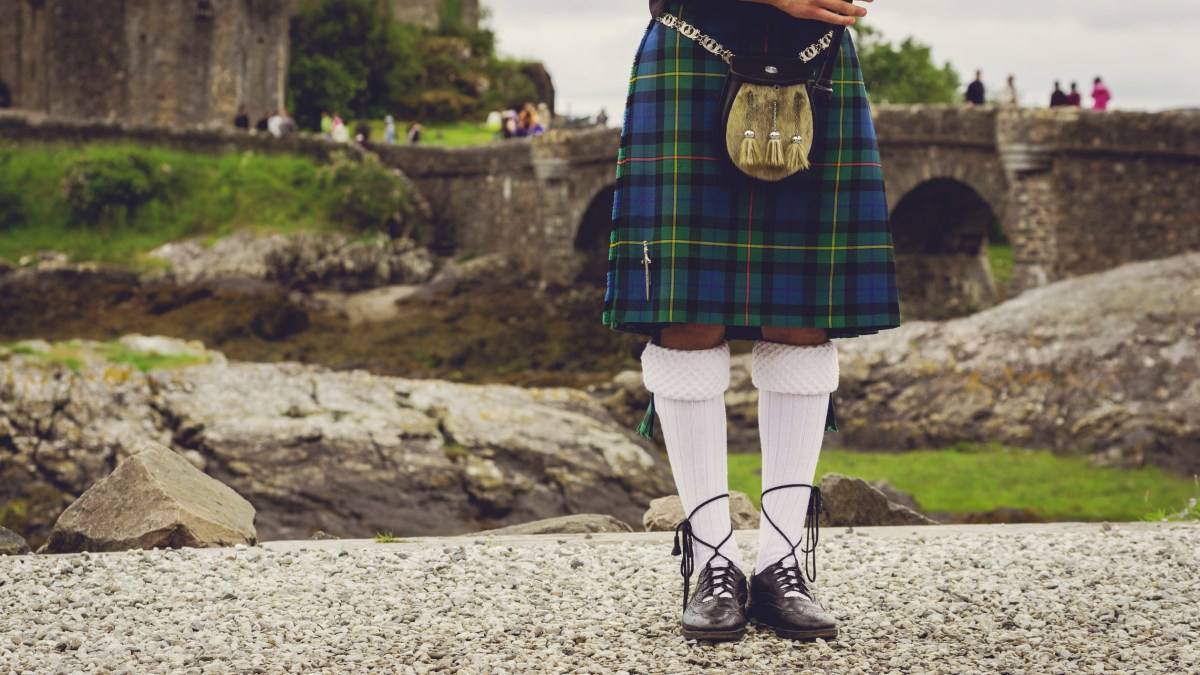Editor’s Note: Last November we had the pleasure of spending 10 captivating days in Scotland. Below is but one adventure of many from our stay. We hope the joy we experienced comes through in all our posts and missives from our adventure, which no doubt read better with a wee dram in hand.
Spend ten days in Scotland and you learn a lot about kilts. First off, they are a helluva lot of fun to wear for a variety of reasons, including:
The House of Edgar is synonymous with quality kilt-making the world over and we were surprised to learn that they produce at least 80 kilts per week.
- Because it’s not just wearing a kilt, it’s wearing a sacred national costume!
- Wearing a kilt is not just buckling on a woolen pleated tartan item; it also includes donning a belt, a specially designed jacket, sporran (a pouch worn on a strap that sits right around the family jewels area-useful since kilts have no pockets), kilt socks, shoes, garter ties, and finally, a kilt pin. The whole outfit is called Highland Dress.
- When you wear one in Scotland nobody looks at you funny. Unless you are wearing it incorrectly. (Hint: the pleats go in the back)
To learn more about all things kilt related, we visited the Macnaughton, a once small family business that started more than 230 years ago on the banks of Loch Tay (located in the central Highlands of Scotland) that is now a holding company for various fabric producers, including The House of Edgar.
If you didn’t already know, the House of Edgar is now the world’s largest manufacturer of traditional Scottish kilts. They not only supply the global highland-wear market, but they also kit-out numerous pipe bands and corporate entities. In short, The House of Edgar is synonymous with quality kilt making the world over and we were surprised to learn that they produce at least 80 kilts per week. Don’t you feel frightfully unfashionable now?

If you ever wondered how Scotland became the only country to buckle into a kilt we did some research for you:
- Originally, kilts were only worn in the Scottish Highlands, not in central or southern Scotland.
- The word “kilt” comes from the old Norse word, “kjilt” which translates to “pleated.” When kilts first came on the scene in the 16th century, they looked much different from what we see today.
- Originally, the kilt was known as a feileadh mhór (philamore) or “big wrap.” This was a thick woolen cloth that stretched across the body and was entirely untailored. This original version of the kilt was extremely versatile thanks to its inherent cloth-like nature. It could be worn over the head in colder weathers and was even said to be used as a camping blanket!
- In later years, following the British Government’s ban against kilts and bagpipes, the kilt evolved again. The feileadh mhór became the feileadh beag (philabeg) or “little wrap,” which is not dissimilar to the kilt we see today.
- While the kilt used to be reserved for special occasions, formal dress, and weddings, we spotted kilts being worn on a daily basis–from hotel staff to young guys out for a drink. Hell, it has even become a required uniform for Scotland’s Tartan Army soccer team and the wearing of one is enthusiastically encouraged for the team’s fans.

We met with Bill Wheelan from the Macnaughton team and asked some basic questions to help guide you in the right direction for when the time comes for you to add a kilt to your closet:
First off, why was the kilt banned in the 18th century?
In August 1747, following the defeat of Bonnie Prince Charlie in the 1745 rebellion, the British Government banned the wearing of kilts. This was an attempt to suppress highland identity and came hand-in-hand with the banning of bagpipes which were seen as an instrument of war.
During this ban, the only people who were legally permitted to wear kilts were military pipers – and they could only wear a kilt in their military tartan.
“No man or boy within that part of Great Britain called Scotland, other than such as shall be employed as officers and soldiers in His Majesty’s Forces, shall… wear or put on the clothes commonly called Highland Clothes” This ban remained in place until 1783.

How much does a typical kilt cost?
While you can have them made by a tailor, off the rack they run around $400-500, plus all accessories. We enjoy doing bespoke kilts for various companies around the world as well. They are great to mark a special occasion or anniversary.
How much fabric does it take to make a kilt?
To make a standard kilt you will need 7.4 meters, which is 8 yards.
Where should a kilt sit on your waist?
Two fingers above belly button.
Originally, tartan colors came from the fauna of your region, so people knew where you were from by the colors you wore.
Where should a kilt fall on the leg?
Center of the knee.
The question every American wants to know the answer to, what do you wear under a kilt?
It is certainly a tradition that no under-garments are worn beneath the kilt but now-a-days it really is just a personal choice for the wearer rather than any strict dressing instruction!
What is the difference between tartan and plaid?
Tartan is registered, while plaid has no back story. Originally, tartan colors came from the fauna of your region, so people knew where you were from by the colors you wore.
Who is buying kilts these days?
Tartan is a steady rock. It’s the most recognized dress in the world. Kilts are really popular with the young kids, now both guys and girls. Apparently you can snag a lady easier!
To buy a House of Edgar kilt stateside check them out here.


